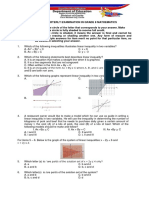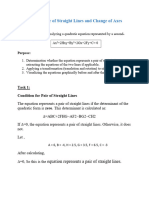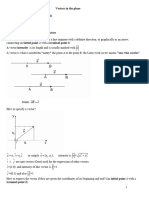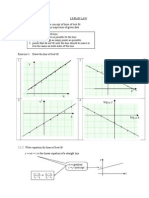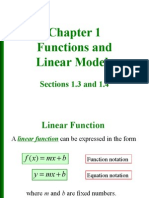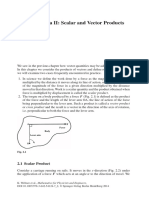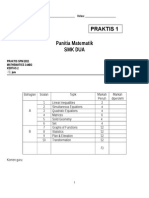Required Linear Functions
Uploaded by
JulieteeySaraniaRequired Linear Functions
Uploaded by
JulieteeySaraniaRequired knowledge and skills: linear functions
Overview
1. Linear function: function whose equation is linear, i.e. has the form
b mx y + =
, where 0 m
2. Graph of a linear function: straight line
a. drawing the graph when the equation is given
b. setting up the equation when the graph is given (see also item !
". #nterpretation of the coefficient m in the equation
b mx y + =
a. slope of the line
b. rate of change: if x increases b$ 1 unit, then y changes b$ m units
c. difference quotient:
1 2
1 2
x x
y y
x
y
m
=
, where P
1
! , (
1 1
y x and P
2
! , (
2 2
y x are points on the
line
d. sign of m determines whether line is increasing or decreasing
e. absolute value of m determines how steep the line is
f. parallel lines have equal slopes
g. slopes of perpendicular lines have product equal to %1
&. #nterpretation of the coefficient b in the equation
b mx y + =
a. b is y'intercept
b. b is function value of 0
c. 0 = b iff origin is on the line
. (etting up the equation of a line
a. if slope m and one point P ! , (
0 0
y x are given: ! (
0 0
x x m y y =
b. if two points are given
). Linear equations:
a. solving linear equations
b. solving other equations leading to a linear equation
c. (graphical! interpretation of the solution of a linear equation: solution of equation 0 = + b mx
i. is x'intercept of the corresponding line
ii. is the *ero of the corresponding linear function
+. Linear inequalities
a. solving linear inequalities
b. graphical interpretation of linear inequalities
i. solutions of 0 > + b mx form interval where corresponding line is above the hori*ontal a,is
ii. solutions of
2 2 1 1
b x m b x m + > + form interval where the line corresponding to left hand side
is above the line corresponding to right hand side
-. #mplicit equation of a line:
0 = + + c by ax
or, equivalentl$,
d by ax = +
, (where a and b are not
simultaneousl$ 0!. hori*ontal and vertical lines
/. Graphical interpretation of the solution of a s$stem of two linear equations: intersection point of the
lines corresponding to the equations
10. 0pplications and word problems involving linear functions, more specificall$: setting up an equation
for one or more linear functions given a description in words and using these equations to solve a
1
problem b$ calculating a function value, solving a linear equation, solving a linear inequalit$, solving
a s$stem of linear equations, 1
Examples
2,ample 1. 3hich of the following functions are linear4 5oreover, in case the function is linear, find out
whether the function is increasing or decreasing.
0.
"
x y =
6.
x y " =
7.
" = x y
8.
= y
2.
! " ( 2 = x y
9.
! " ( = x x y
G.
2
" ! " ( x x x y =
:.
" = x y
2,ample 2. 9ind the equation of the line through the points
! 1 , 2 ( P
and
! 2 , 1 ( Q
.
2,ample ". 9ind the equation of the line through the point
! 1 , 2 ( P
and parallel to the line through
! 2 , ( Q
and
! . & , 0 ( R
.
2,ample &. 9ind the equation of the line through the origin and perpendicular to the line having equation
" 2 + = x y
.
2,ample . 0re the lines
& " 2 = + y x
and
& 2 " = y x
perpendicular to each other4
2,ample ). 9ind the intersection point of the lines
& " 2 = + y x
and
& 2 " = y x
.
2,ample +. ;he cost of c of producing q units of a certain good consists of two parts. ;here is a fi,ed cost
of 2-0 2<=, plus a variable cost of " 2<= per unit produced. 3rite an equation giving the cost c in terms
of the number q of units produced.
2,ample -. 0 new product was launched in 200&. ;he graph below shows how man$ units of this product
were sold in the $ears 200& to 200+. #f the sales continue increasing in the same wa$, how man$ units of
the product will be sold in 20104
2,ample /. ;he cost c of a ta,i ride of x >m is given b$ the equation x c - . 0 + = . 5a>e a graph
showing the price of ta,i rides for a distance between 0 and 10 >m.
2,ample 10. 0 first electricit$ compan$ charges a fi,ed rate of 100 2<= per $ear and 0.2 2<= per
>ilowatt'hour of electricit$ consumed. 0 second compan$ has no fi,ed rate, but charges 0.22 2<= per
2
>ilowatt'hour consumed. 9ind out for which $earl$ consumption of electricit$ the second compan$ is
cheaper than the first one.
Solutions to the examples
2,ample 1. 6 (increasing!, 7 (increasing!, 2 (decreasing!, G (decreasing!, : (increasing!
2,ample 2.
" + = x y
2,ample ".
2 . 0 + = x y
2,ample &.
x y . 0 =
2,ample . $es
2,ample ). intersection point has coordinates
1"
&
,
1"
20
2,ample +.
q c " 2-0 + =
2,ample -. 1) 000
2,ample /. see graph below
2,ample 10. $earl$ consumption below 000 >ilowatt'hours
3
You might also like
- Second Periodical Test in Grade 8 Mathematics90% (73)Second Periodical Test in Grade 8 Mathematics6 pages
- Dot Products and Angles Via MathematicaNo ratings yetDot Products and Angles Via Mathematica12 pages
- Graphical Method of Solution of A Linear Programming ProblemNo ratings yetGraphical Method of Solution of A Linear Programming Problem8 pages
- Summer 2012 Precalculus Section 1.5 Lecture NotesNo ratings yetSummer 2012 Precalculus Section 1.5 Lecture Notes9 pages
- Makalah Quadratic Function in EconomicsNo ratings yetMakalah Quadratic Function in Economics25 pages
- Cartesian Coordinate Geometry and Straight Lines-3No ratings yetCartesian Coordinate Geometry and Straight Lines-365 pages
- Polynomial Degree and Finite DifferencesNo ratings yetPolynomial Degree and Finite Differences32 pages
- IA-04Scalar (Dot) Product of Two Vectors (23-27)No ratings yetIA-04Scalar (Dot) Product of Two Vectors (23-27)2 pages
- 1.HIGH School V GEOMETRY-Vectors in The Plane-Part 1No ratings yet1.HIGH School V GEOMETRY-Vectors in The Plane-Part 16 pages
- Y MX + C Is The Linear Equation of A Straight Line Y: y y y y or X X X XNo ratings yetY MX + C Is The Linear Equation of A Straight Line Y: y y y y or X X X X12 pages
- Topic 3: Straight Line and Applications: Week 3: Lecture NotesNo ratings yetTopic 3: Straight Line and Applications: Week 3: Lecture Notes47 pages
- Vector Algebra II: Scalar and Vector ProductsNo ratings yetVector Algebra II: Scalar and Vector Products16 pages
- Class9 - Linear Equation in Two Variables - AssignNo ratings yetClass9 - Linear Equation in Two Variables - Assign2 pages
- Student's Solutions Manual and Supplementary Materials for Econometric Analysis of Cross Section and Panel Data, second editionFrom EverandStudent's Solutions Manual and Supplementary Materials for Econometric Analysis of Cross Section and Panel Data, second editionNo ratings yet
